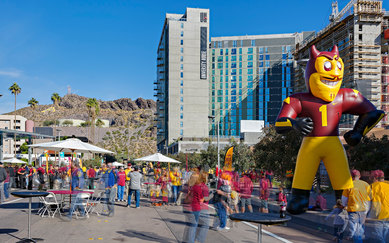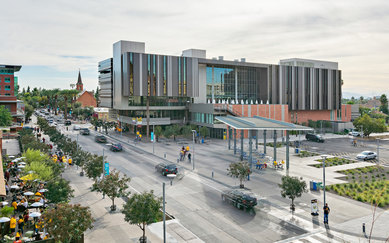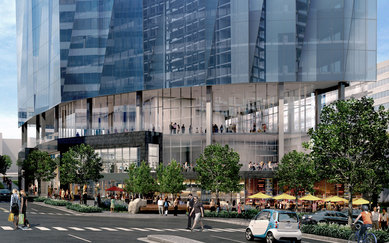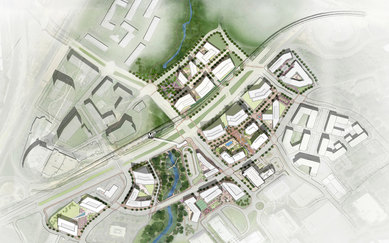Shaping Urban Environments Around Transportation Innovation

The way we plan and experience our cities has been largely dictated by the automobile for the better part of a century. Those paradigms are currently being challenged by emerging technologies and opportunities that could drive a new mobility future. Autonomous and connected vehicles will offer new ways to think about and use street right-of-way, and potentially provide more flexible and equitable forms of mobility. At the same time, these opportunities pose new challenges. For example, making personal automobile travel easier and more attractive could increase the number of trips taken and the distance people are willing to drive, increasing rather than reducing traffic congestion.
As planners, designers, and citizens, we must creatively rethink, adapt, and improve our cities to prioritize human contact and public health, advance sustainability and resiliency, and minimize the negative impacts of new forms of vehicular travel. This won’t be easy, as this isn’t only about changing physical environments, but changing firmly established living, working, and commuting patterns and individual preferences.
Recent studies have revealed that these larger cultural shifts in transportation choices will require more than physical environment change. For example, despite all the infrastructure improvements made in the U.S. from 2007 to 2016 – widened roads, transit lines built, ride-hailing services launched, and bike share systems introduced – no individual transportation mode saw its share of total commuters change more than 1.5 percentage points. This same Brookings Institute study on how Americans commute indicates that the U.S. has not become more transit-oriented in its transportation preferences. Using 2016 census data, Brookings found that 85 percent of Americans either drive alone or carpool to work – and that roughly the same percentage of people work from home as take public transit.
Similar issues were raised in a recent report by the New York-based TransitCenter. Using data from the U.S. Department of Transportation’s National Transit Database, their research found that transit ridership fell in 31 of 35 major metropolitan areas in the United States last year, with losses largely related to buses. This is ultimately not a sustainable situation for growing urban areas, even with the promise of new mobility options. As a Washington Post article about the study pointed out:
Planners warn that cities simply do not have the capacity to handle a wholesale shift to other vehicular modes — whether today’s version of ride hailing, driving or eventual ride sharing through autonomous vehicles. Those alternatives . . . are no match for “the basic geometry problem that only transit can solve — which is to move large numbers of people through a city in very little space.”
This is why one of the key recommendations in the 2017 paper Driverless Future: A Policy Roadmap for City Leaders is to prioritize and modernize public transit. Autonomous vehicle (AV) technology must be integrated with mass transit systems, helping to make them more convenient and competitive, as an integral part of adopting and adapting to the new technology.
As we anticipate a rapidly shifting mobility context in the next decade, developers must anticipate, advocate for, and design for the holistic future of urban mobility – a future that by necessity will be increasingly multimodal while incentivizing transitional shifts to more sustainable transportation infrastructure solutions. One way to start is to focus on new flexible ways to shape land and buildings. These include things that we encounter every day, such as how we use land, plan for open space and infrastructure, and design our streets. The technology related to automobiles is changing rapidly, causing an extreme sense of urgency. We must act now to ensure that the design of our cities stays ahead of technological innovation.
Three Principles to Inform Future Mobility
To sustainably advance new technological innovations in mobility and transportation, three core principles should guide our planning and design thinking.
1. Adapt Spaces for People First. Our cities should be built and adapted for people first, emphasizing public health outcomes and human-powered movement, and balancing space for cars with places for human connection and contact.

Undertaken as a P3 with Arizona State University and the City of Tempe, Tempe’s College Avenue redesign exemplifies how a complete-streets approach can integrate and balance a wide range of mobility options while also supporting public events and business-enhancing, placemaking uses of adjacent right-of-way.

2. Create Truly Sustainable + Resilient Places. While compact urban cores represent the most sustainable form of development, they often fall short of goals to not only do less environmental harm but to also mitigate climate change, withstand and recover from chronic stresses and acute shocks, and generally improve quality of life for all residents. Along with technological advances, cities must emphasize systematic, sustainable and resilient performance of their public realm and mobility networks to ensure success for generations to come.


A restored creek corridor lies at the center of the transit-oriented, mixed-use redevelopment plan for Scott’s Run Station in Tysons, Virginia, infusing environmental restoration and recreational amenities into a dynamic urbanizing vision for this former suburban edge city.
3. Be Action Oriented. Our cities must work to establish a new, paradigm-shifting relationship with automobiles. We don’t need to wait for autonomous vehicles to reduce or remove zoning parking minimums, decouple proximate requirements for parking from land uses, and recapture space for affordable housing, naturalized open space, and people-oriented uses to ensure that our cities are inclusive and accessible to all. We must lead with flexible and forward-thinking solutions and policies. And we must start now.
These principles are further highlighted in a chapter of the upcoming Routledge book, "Toward Just and Sustainable Mobilities: Driverless Cars, Transport Innovation and the City of Tomorrow". The chapter is co-authored by Michael Johnson, Co-Director of SmithGroup’s Urban Design Practice, and William Riggs, Assistant Professor at the University of San Francisco. The book is based on a recent symposium hosted by the University of San Francisco, entitled “Autonomous Vehicles and the City: A Symposium Developing Policies and Plans for Livability”.
Michael Johnson’s post on this symposium can be read here.